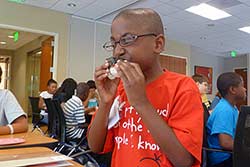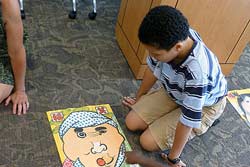Japanese Culture Summer Camp 2012
July 9-13
A group of about 30 rising 6th-graders were given the chance to experience various facets of Japanese culture through the Consulate-General of Japan’s Summer Camp program. Each day the children were given the opportunity to try out something new, expanding their knowledge and interest in Japan, and volunteers generously offered their assistance in preparing each day’s activities.
On the first day of the summer camp, the children were given an introduction to Japanese culture, including Japanese daily life and a shortened version of the Consulate’s Japan Caravan school presentation. Other activities included making Japanese kites and learning about Tanabata, a Japanese festival every July 7th.
On the second day of summer camp, participants got a lesson in Japanese language, learning how to write their names in Japanese and learning many commonly used words. They also got to try their hands at making onigiri, or rice balls, and Ms. Elaine Jo of Washi Accents taught them about ikebana, or flower arrangement.
The third day of summer camp gave the children the chance to learn about schools in Japan, to see what Japanese school uniforms are like and even to try on some parts of uniforms. Afterward, members of the local Konnichiwa Club taught the children how to make origami tops. Finally, the children got to play with various traditional Japanese toys, such as kendama and daruma-otoshi.
On day four of the summer camp, early arrivers got a bit of a treat with gag anime showing on the screen for the first 45 minutes of the day or so. Afterward, guest teacher John Moale taught the children about Japanese music, helping them to make a small taiko drum and teaching them the melody of ‘Sakura Sakura’ on his shamisen. For the day’s final activity, Mitsu Uchida-sensei taught the children some karate basics, including how to line up for practice, how to show respect for the teacher and each other, and how to exercise for karate.
For the fifth and final day of summer camp, students learned about Japanese clothing, getting the chance to try on a yukata (light cotton kimono) or happi coat, and getting their pictures taken. Guest teacher Masako Yamakami taught the children how to write their names in Japanese and led the class in a calligraphy lesson. Finally, Ms. Tomoko Aoyagi presented a Japanese tea ceremony for attendees to try Japanese sweets and green tea in a (semi-) formal setting.









